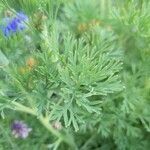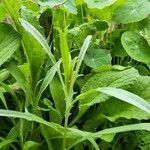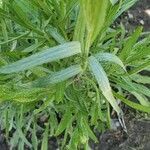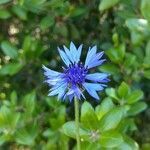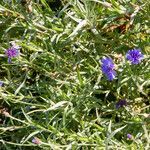Annuals, 20–100 cm. Stems usually 1, erect, ± openly branched distally, loosely tomentose. Leaves ± loosely gray-tomentose; basal leaf blades linear-lanceolate, 3–10 cm, margins entire or with remote linear lobes, apices acute; cauline linear, usually not much smaller except among heads, usually entire. Heads radiant, in open, rounded or ± flat-topped cymiform arrays, pedunculate. Involucres campanulate, 12–16 mm. Phyllaries: bodies green, ovate (outer) to oblong (inner), tomentose or becoming glabrous, margins and erect appendages white to dark brown or black, scarious, fringed with slender teeth ± 1 mm. Florets 25–35; corollas blue (white to purple), those of sterile florets raylike, enlarged, 20–25 mm, those of fertile florets 10–15 mm. Cypselae stramineous or pale blue, 4–5 mm, finely hairy; pappi of many unequal stiff bristles, 2–4 mm. 2n = 24 (Russia).
Annual or winter-annual 2–12 dm, usually loosely white-tomentose when young, the lower lf-surfaces often persistently so; lvs narrow, often linear, entire, or the lower ones a little toothed or with a few narrow lobes, to 13 × 1 cm (excluding the lobes); heads terminating the branches; invol 11–16 mm, its bracts ± striate, with a relatively narrow, often darkened, pectinate or lacerate fringe near the tip; fls mostly blue, sometimes pink, purple, or white, the marginal ones enlarged; pappus 2–3 mm; 2n=24. Fields, roadsides, and waste places; native to the Mediterranean region, widely cult. and now a cosmopolitan weed.
Annual herb, up to 600 mm high. Stems slender, sericeous, not winged. Leaves alternate, sessile; blade linear, apex acute, margins entire, lower leaves sometimes sparsely lobed, lower surface white-woolly. Heads radiate, solitary, terminal. Involucral bracts glabrous, in several rows, imbricate, without spines, apical margins lacerate, often purple-tinged. Flowers: ray and disc florets blue, purple or white; Nov. Fruit with cypsela narrowly obovoid, compressed, light and dark grey, slightly sericeous. Pappus of many unequal bristles, 3-4 mm long.
Annual herb, up to ± 0.6 m high; ascending branches; stems slender, sericeous. Leaves linear or lanceolate, entire, white-woolly below. Involucral bracts unarmed, deltoid, ovate to lanceolate, membranous, glabrous, margins chartaceous and regularly lacerate. Florets blue, purple or white. Flowering time July, Aug. Cypselae compressed, slightly sericeous.
Annual herb, 0.2-1.0 m high. Leaves linear or lanceolate, entire, white woolly below. Heads radiate. Involucral bracts unarmed, margins regularly lacerate. Flowers blue, purple or white.
Pending.
